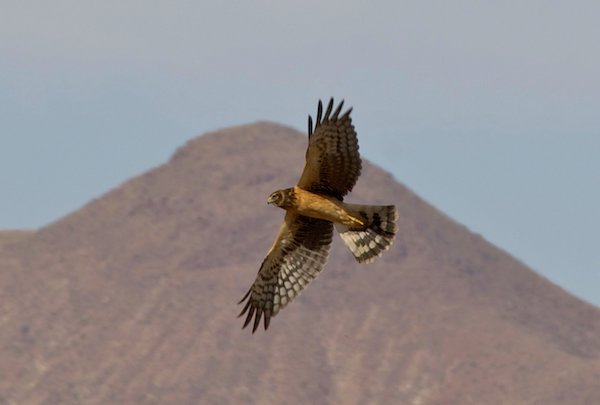
BY HARRY WEEKES
There is an episode in the Star Trek series (this one from Voyager) where our friends in the Federation detect a warp signature on a distant planet. Warp signatures are important indicators of a civilization. If a civilization has the ability to develop warp drive, it has reached a technological and developmental level that implies a certain advancement. Detecting that advancement, Starfleet swoops in to give things a little look.
In this instance, though, they found what appeared to be an emerging civilization—one that had all the cliché trappings of an early agrarian society we might associate with 10,000 BCE. The plot twist was simple—this civilization had developed warp drive. And then they realized all the negative that came along with it and so they actively chose not to explore it any further and to keep so-called “advanced technology” away.
Naturally, I was thinking about this as two northern harriers returned to our canyon this spring.
For at least the last five years, a pair of harriers has chosen our little patch of sagebrush as its mating and breeding grounds. Harriers are known for and often identified by their low, gliding flight that has them rocking back and forth in the air, often within 15 feet of the ground.
The males are a distinct gray-blue and the females a chestnut brown. Each of them has a clear white rump patch and an owl-like facial disc. Often, the first evidence of them is a streaking shadow over our lawn or flitting through the house. We go to the windows to find them gliding through the hills. Their mating ritual looks like what someone would do if they could fly—the birds shoot up into the air and then come down in great swooping arcs. They fold their wings, shoot them back out again, barrel roll, and otherwise display a command of the air that is both playful and impressive.
And when the mating dance works, they set up a nest. From our vantage point, this is when they drop into a patch of sagebrush… repeatedly.
Over the next weeks, the male and female take turns returning to one spot—a spot so hidden that they seem to search for it each time. Cruising back and forth over a section of sage, they find whatever telltale signs they are looking for, make a sharp turn, and then flutter into the bushes.
I know approximately where this spot is. Close enough that with a determined search, I know I could find it.
But I don’t. I don’t even look.
And this is very, very hard for me.
In the sagebrush, not 30 feet off our driveway, is a harrier nest. It will have eggs. And then chicks. And then fledglings. The parents will guard it, tend it, and then begin intently feeding their babies. And none of them needs me lumbering into the bushes, no matter how quietly I think I can move, looking to find where they are hiding.
There would be benefits, for sure. I could tell you what a harrier nest looks like. If their eggs are speckled. What kind of creatures they bring back. And even what the chicks look like in all their fuzzy cuteness.
And then, maybe my dogs would know where they were. Or the adults would abandon the nest, and even our canyon. And I would trade a certain kind of knowing for the annual return and rhythm of these birds that is still cloaked in the mysterious.
So, I intentionally do not know. I do not find out. I sit back and let the questions and what-ifs roll over me. And through this, I realize that there is a very good chance all of this makes me more curious, not less. And that seems like progress.
Harry Weekes is the founder and head of school at The Sage School in Hailey. This is his 52nd year in the Wood River Valley, where he lives with Hilary and one of their three baby adults—Simon. The other members of the flock are Georgia and Penelope (Georgia recently fledged from Davidson College in North Carolina and Penelope is at Middlebury College in Vermont).


